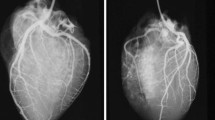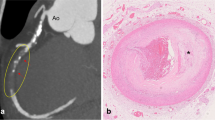Abstract
The role of imaging has been long established in forensic practice as an adjunct to the conventional autopsy. Recently with the development of MDCT, there has been a large international push towards the development of the so called “near virtual autopsy.” Currently a large obstacle to the acceptance of “near virtual autopsies” is the failure of post-mortem imaging to yield detailed information about the coronary arteries. This is a major deficiency of post-mortem MDCT and MRI compared to conventional autopsy as standard clinical angiography relies on circulation. One possible way to overcome this is by the use of post-mortem MDCT angiography. This review paper considers the past, current and future advances in cadaver cardiac imaging which, if successful, will take radiological imaging one step closer to the widespread introduction of near virtual autopsies.






Similar content being viewed by others
References
Donchin Y, Rivkind AI, Bar-Ziv J, Hiss J, Almog J, Drescher M. Utility of postmortem computed tomography in trauma victims. J Trauma. 1994;37:552–5.
Jeffery AJ. The role of computed tomography in adult post-mortem examinations: an overview. Diagn Histopathol. 2010;16:545–51.
Levy AD, Harcke HT, Getz JM, Mallak CT. Multidetector computed tomography findings in deaths with severe burns. Am J Forensic Med Pathol. 2009;30:137–41.
Fan JKM, Tong DKH, Poon JTC, et al. Multimodality minimally invasive autopsy—a feasible and accurate approach to post-mortem examination. Forensic Sci Int. 2010;195:93–8.
Weustink AC, Hunink MG, van Dijke CF, Renken NS, Krestin GP, Oosterhuis JW. Minimally invasive autopsy: an alternative to conventional autopsy? Radiology. 2009;250:897–904.
O’Donnell C, Woodford N. Post-mortem radiology—a new sub-speciality? Clin Radiol. 2008;63:1189–94.
Sieswerda-Hoogendoorn T, van Rijn RR. Current techniques in postmortem imaging with specific attention to paediatric applications. Pediatr Radiol. 2010;40:141–52.
Thayyil S, Robertson NJ, Sebire NJ, Taylor AM. Post-mortem MR and Ct imaging in fetuses, newborns and children: an evidenced based approach. Diagn Histopathol. 2010;16:565–72.
Rutty GN. High throughput adult cadaver axial imaging; service logistics and requirements. Diagn Histopathol. 2010;16:573–7.
Roberts WT, Bax JJ, Davies LC. Cardiac CT and CT coronary angiography: technology and application. Heart. 2008;94:781–92.
Winchester DE, Wymer DC, Shifrin RY, Kraft SM, Hill JA. Responsible use of computed tomography in the evaluation of coronary artery disease and chest pain. Mayo Clin Proc. 2010;85:358–64.
Sun Z, Ng KH. Multislice CT angiography in cardiac imaging. Part II: clinical applications in coronary artery disease. Singapore Med J. 2010;51:282–9.
Grabherr S, Djonov V, Yen K, Thali MJ, Dirnhofer R. Postmortem angiography: review of former and current methods. Am J Roentgenol. 2007;188:832–8.
Grabherr S, Gygax E, Sollberger B, et al. Two-step postmortem angiography with a modified heart lung machine: preliminary results. Am J Roentgenol. 2008;190:345–51.
Ross S, Spendlove D, Bolliger S, et al. Postmortem whole-body CT angiography: evaluation of two contrast media solutions. Am J Roentgenol. 2008;190:1380–9.
Jackowski C, Persson A, Thali MJ. Whole body postmortem angiography with a high viscosity contrast agent solution using poly ethylene glycol as contrast agent dissolver. J Forensic Sci. 2008;53:465–8.
Thali MJ, Dirnhofer R, Vock P, editors. The virtopsy approach: 3D optical and radiological scanning and reconstruction in forensic medicine. London: CRC Press/Taylor & Francis; 2009.
Yonas H, Boehnke M, Wolfson S. Radiopaque silicone rubber and xeroradiography for the high-resolution visualization of the cerebral vasculature. Surg Neurol. 1982;17:130–1.
Smith M, Trummel DE, Dolz M, Cina SJ. A simplified method for postmortem coronary angiography using gastrograffin. Arch Pathol Lab Med. 1999;123:885–8.
Schultz TC. Simple method for demonstrating coronary arteries at postmortem examination. Am J Forensic Med Pathol. 1987;8:313–6.
Russell GA, Berry PJ. Post mortem radiology in children with congenital heart disease. J Clin Pathol. 1988;41:830–6.
Grabherr S, Djonov V, Friess A, et al. Postmortem angiography after vascular perfusion with diesel oil and a lipophilic contrast agent. Am J Roentgenol. 2006;187:515–23.
Jackowski C, Sonnenschein M, Thali MJ, et al. Virtopsy: postmortem minimally invasive angiography using cross section techniques–implementation and preliminary results. J Forensic Sci. 2005;50:1175–86.
Jackowski C, Bolliger S, Aghayev E, et al. Reduction of postmortem angiography-induced tissue edema by using polyethylene glycol as a contrast agent dissolver. J Forensic Sci. 2006;51:1134–7.
Acknowledgments
We wish to thank the relatives of the deceased who consented for their recently departed loved ones to be imaged as part of the on-going MDCT angiography research at the East Midlands Forensic Pathology Unit, Leicester, UK (LREC number 04/Q2501/64). Without their consent work within this area could not progress. We wish also to thank the radiographers, porters, anatomical pathology technicians and those undertaking consenting for the day to day logistical support for the trial.
Conflict of interest
None.
Author information
Authors and Affiliations
Corresponding author
Rights and permissions
About this article
Cite this article
Saunders, S.L., Morgan, B., Raj, V. et al. Post-mortem computed tomography angiography: past, present and future. Forensic Sci Med Pathol 7, 271–277 (2011). https://doi.org/10.1007/s12024-010-9208-3
Accepted:
Published:
Issue Date:
DOI: https://doi.org/10.1007/s12024-010-9208-3




